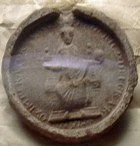

Umbri
Prestige grave goods from this area suggest the emergence of a ruling (probably Umbrian) élite in the 8th century BC that had developed close trading relations with its Etruscan neighbours across the Tiber. The cosmopolitan nature of the area arose from its proximity to the river, and from its equally important access to the passes across the Apennines that led to the Adriatic coast.
For more details, see the page on Ancient Città di Castello.
Romans
Pliny the Elder listed the Tifernates as among the people of the Augustinian Sixth Region of Umbria. This Roman name for the people of what became Città di Castello probably referred to its proximity to the Tiber.
Writing in the 1st century AD, Pliny the Younger described a village near his property that was called Tifernum Tiberinum "in Tuscos" (in Tuscany).
For more details, see the page on Tifernum Tiberinum: Roman Città di Castello and
Early Christianity
According to tradition St Crescentian, a Roman soldier in the reign of the Emperor Diocletian, brought christianity to the city. At the onset of the anti-Christian persecution of 303 AD, he fled from Rome along the Tiber to “agro Tiphurnati”. He evangelised the area and became famous when he killed a dragon there. When this news reached the Diocletian, who ordered the Etrurian Prefect Flaccus to investigate. When St Crescentian refused to make a pagan sacrifice in the forum, Flaccus ordered that he should be beheaded. Some Christians retrieved his body and buried him in Pieve dei Saddi (now in the Commune of Pietralunga, some 10 km from Città di Castello).
The earliest documented bishop of Città di Castello is Eubodius, who attended a synod in Rome in 465 AD.
A bishop Marius attended a synod in Rome in 499, followed by Innocentius in 501-4.
Goths
“The virtuous Bishop Floridus” is mentioned in the Dialogues (593) of Pope Gregory I as the source for his accounts of two saints:
-
✴St Herculanus, whom St Floridus had described as “the great holy man ..., the Bishop of Perusia, who brought me up”; and
-
✴St Amantius, a priest “of holy life and worthy to be credited”, with whom St Floridus shared a dwelling.
The earliest known legend, the Vita Floridi (BHL 3062), was written in 1077 by Canon Arnolfo of Arezzo. This relates that SS Floridus and Amantius were in Perugia when Totila besieged it (in 549). When they travelled to Città di Castello from Perugia, they found the city and its original duomo (which local tradition says was dedicated as Santo Stefano) in ruins. St Floridus organised their rebuilding, and Pope Pelagius II consecrated him as the city’s bishop in ca. 580. As he approached death (traditionally in 599), he moved with St Amantius to Pieve dei Saddi and built a house on the burial site of St Crescentian (above). He died there on 13th November, attended by three bishops:
-
✴Laurence of Arezzo;
-
✴Leontius of Urbino; and
-
✴“Habentius” of Perugia.
The last name is thought to have been a corruption of Venantius, the bishop of Perugia who received a letter from Gregory I in 604.
Lombards
When Arezzo was occupied by the Lombards in the late 6th century, Città di Castello, became known as Castrum Felicitatis and was part of the Regio Castellorum of the so-called Byzantine corridor between Ravenna and Rome.
[Bishop Albert and the deacon Brictius were martyred in 711]
Castrum Felicitatis subsequently fell to the Lombards and formed part of “Tuscia Langobardorum” (Lombard Tuscany) the Kingdom of Lombardy. King Liutprand (714-41) elevated it to a county.
Carolingians
Città di Castello remained part of “Tuscia Langobardorum” (Lombard Tuscany) until 781, when the Emperor Charlemagne incorporated it into the Carolingian province of “Tuscia Romana” (Roman Tuscany). Charlemagne nominated Arimberto del Monte as his vicar of Castrum Felicitatis and Arezzo.
Bishop Roderico (Rodericus Episcopus Castellana) attended a the synod in Rome convened by Leo IV in 853.
Saracens sacked Città di Castello in 857 and Magyars sacked it again in 917.
The city was known as Civitas Castelli after the 10th century.
11th Century
Bishop Peter II (ca. 1023-48) enjoyed the confidence of Pope John XIX, who asked him to arbitrate in a dispute between the bishops of Arezzo and Siena in 1029. St Peter Damian nevertheless pressed for his deposition in 1045, along with that of the bishops of Fano and Pesaro. The reasons for this are unknown, but they might well have centred on disagreement about Church reform.
12th Century


Bishop Pietro IV (1153-67) seems to have been papal appointments. However, the Emperor Frederick I tried to impose a bishop called Corbello on Città di Castello in 1159. The diplomas above, which he issued in 1163 in favour of (respectively) Corbello and his associate, Prior Raniero, the schismatic head of the cathedral canons, is now in the Museo del Duomo. It placed them under imperial protection and exempted their possessions from restitution to their exiled predecessors.
It seems that the canonically appointed Bishop Peter was able to return to his post in 1164. However, Frederick I may well have imposed another bishop called Tedelmannus who was documented in 1167.
The first known consul of Città di Castello, Cassolo, is documented in 1167.
Bishop Peter (1172-8) might have been Pietro IV or a successor.
After the Peace of Venice (1177), the episcopal situation was probably settled with the appointment of Bishop Ranieri II (1178-1204).
Frederick I granted the city to Perugia in 1180, but this subjugation was not sustained.
Philip of Swabia, the brother of the Emperor Henry VI claimed jurisdiction over Città di Castello as Duke of Tuscany (1195-8). The city found his exactions intolerable, and appealed to Henry VI.
13th century
See the page on Città di Castello in the 13th Century.
14th century
See the page on Città di Castello in the 14th Century.
15th century
See the page on Città di Castello in the 15th Century.
16th century
See the page on Città di Castello in the 16th Century.
Later History
Negotiations for the return of the Jesuits to Città di Castello began in 1823 (after Pope Pius VII re-instituted the order in 1814. There was considerable political opposition, but they finally returned in 1844. They negotiated with Luigi Bufalini on a 99 year lease on Palazzo Bufalini in order to build a new college, and secured the approval of Pope Pius IX for the project. The college opened in 1846 but the political situation deteriorated and they were driven from the city in 1848.
Città di Castello rebelled unsuccessfully against papal control following the death of Pope Benedict XIV in 1758. The leading dissidents were severely punished, but Bishop Giovanni Battista Lattanzi was able to secure an amnesty from Pope Clement XIII soon after his election in the following year.
Città di Castello suffered a terrible earthquake in 1789.
On 13 January 1798, the troops of the Cisalpine Republic under General Giuseppe Lechi of Brescia entered the city, followed on 1st February by French reinforcements. Città di Castello became the first Umbrian city to embrace the Jacobin revolution. A tree of liberty was erected in the main piazza to commemorate the formation of the Roman Republic two weeks later. However, the mood was soured when General Lechi appropriated Raphael’s panel of the Marriage of the Virgin from San Francesco. This gave rise to a revolt known as the “viva Maria”: on 5th May, some 150 French soldiers were killed, together with Giulio Bufalini, the President of the municipal government, and some of his colleagues. A French army soon put down the revolt and inflicted severe reprisals. All of this was followed by another earthquake, in September 1798.
Austrian troops took Città di Castello in June 1799. From this point, the city reverted to the Papal Staes, except for three short periods:
-
✴it was annexed to the French Empire in 1809-1814;
-
✴its citizens established a Provisional Committee in 1831; and
-
✴it became part of the Roman Republic in 1849.
Piedmontese soldiers under General Fanti liberated the city on 11th September, 1860, and its people voted in a referendum to join the new Kingdom of Italy.
Return to the home page on Città di Castello.

